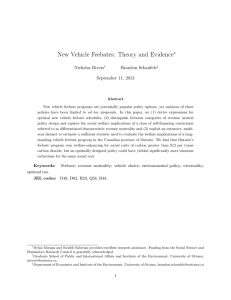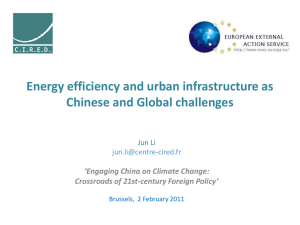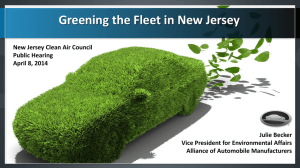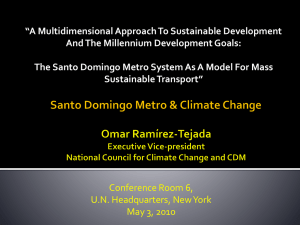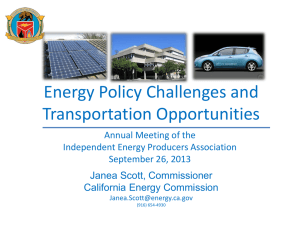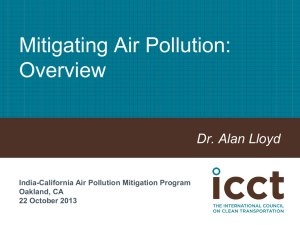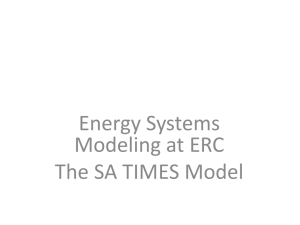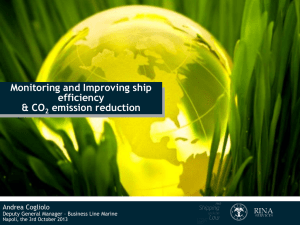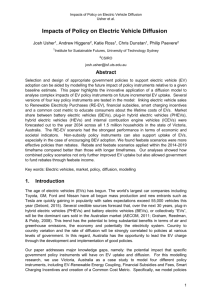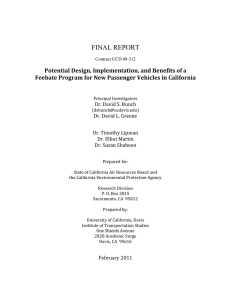View Conference Presentation
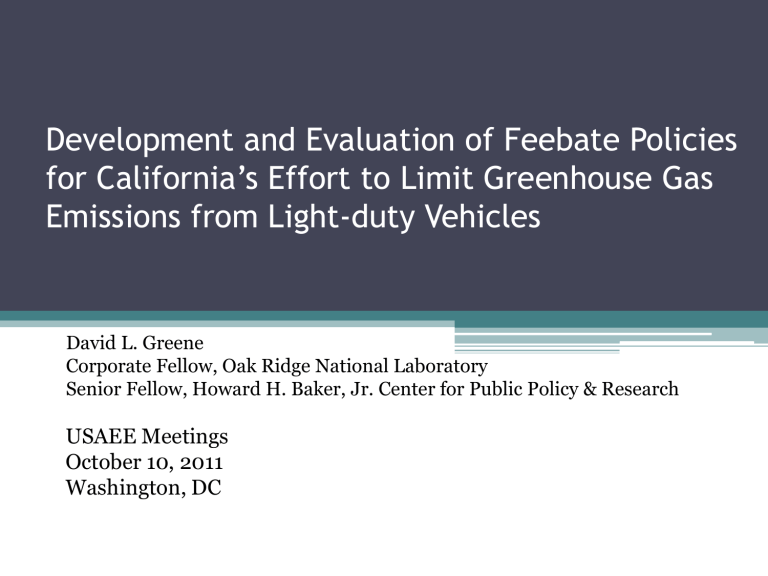
Development and Evaluation of Feebate Policies for California’s Effort to Limit Greenhouse Gas
Emissions from Light-duty Vehicles
David L. Greene
Corporate Fellow, Oak Ridge National Laboratory
Senior Fellow, Howard H. Baker, Jr. Center for Public Policy & Research
USAEE Meetings
October 10, 2011
Washington, DC
Feebates are a policy for encouraging car buyers to prefer more efficient, lower emission vehicles and manufacturers to design them.
• A fiscal policy combining graduated
▫ FEEs on inefficient vehicles
▫ Re BATEs on efficient vehicles .
• A “benchmark” defines who pays and who receives. (distribution)
• A “ rate ” determines the marginal costs and benefits. (efficient solution)
• Depending on the choice of benchmark, feebates can produce revenue, be revenue neutral or be a net subsidy to car purchases
• The dual of fuel economy standards?
Simplest feebate is linear in energy use or CO
2 emissions per mile.
Benchmark is E
0
. Rate is slope of the line.
System is revenue neutral if benchmark is carefully chosen.
$
Feebate
0
E
E
E o
Today, 16 countries have some form of CO
2 or fuel consumption (l/100km) tax on light-duty vehicles.
• New vehicle purchase or registration:
▫ Austria, Canada, Finland, France, Ireland,
Netherlands, Norway, Portugal, Spain, U.S.A.
• Annual or recurring registration fee:
▫ Denmark, Germany, Ireland, Luxembourg, Portugal,
Sweden, UK
• Source: N.A. Braathen, 2010. “Incentives for CO2 Emission Reductions in Current
Motor Vehicle Taxes”, ENV/EPOC/WPNEP/T(2009)2/FINAL, Environment
Directorate, OECD, Paris.
France’s Bonus/Malus had an immediate effect, lowering the average emissions of cars sold by 7 g/mi., entirely due to car buyers choosing lower emission vehicles.
In the ARB Feebates model, the technological potential to increase fuel economy/reduce emissions was represented by cost curves.
Manufacturers redesign approximately one fifth of their models each year.
Fuel Economy Cost Curves Technology Cost Curves
Mid-Size Passenger Car
$3,000
$2,500
$2,000
2007-2014
2015-2022
2023-2025
$1,500
$1,000
$500
$0
0 10 20 30 40
Percent Increase in MPG
50 60 70
6
The NMNL vehicle choice model estimated market shares of
20 vehicle classes and more than 800 individual vehicle configurations, as well as to buy a new vehicle or not.
7
Most feebate systems analyzed were benchmarked to the CAFE footprint function.
8
56 cases were analyzed, reflecting a comprehensive set of feebate designs in various contexts.
• 13 cases analyzed differences in
▫ Feebate rate: $10/$20/$30 per gram per mile
▫ Geographical coverage: CA, CA + opt-in states, All of US
▫ Benchmark: footprint, single, car or truck
▫ Functional form: linear or step function
• 22 sensitivity cases considered the effects of
▫ Fuel prices
▫ Technology costs
▫ How consumers value fuel savings
▫ Other parameters
• 17 additional cases considered alternative post 2016 standards
• 4 more cases assessed whether feebates could replace the CA standard, plus the effects of banking emissions credits.
• Consumers assumed to require a simple 3-year payback.
9
The reference case included the fuel economy/emissions standards to 2016 and two alternative paths to 2025.
10
The impact of a CA feebate system increases almost linearly with the size of the feebate rate.
11
Considering the full value of fuel savings, the full costs per ton of CO
2 avoided are negative. Why?
12
The greater the market coverage of the feebate system, the greater its impact on emissions.
13
For a California feebate, most of the impact is due to sales-mix shifts, less to increased use of technology.
14
For a nationwide feebate system, most of the impact is due to increased use of fuel economy technologies.
15
The footprint benchmark has the smallest impact on consumers’ surplus, a single point benchmark the largest.
16
Does the public support fiscal policies or not?
17
Key findings are…
• With emissions standards in effect, feebates will further reduce LDV GHG emissions unless the standards are so strict as to induce pricing by OEMs.
• Reductions of 5 to 20 g/mi occur immediately, depending on the size of the feebate rate ($10 to $30).
• Reductions are obtained at negative cost, assuming car buyers typically undervalue future fuel savings relative to expected value.
• Impacts will diminish over time if standards are very strict and technological progress is slow.
• Feebates could have a very large or very little impact on hybrid vehicle sales, depending on future costs of hybrids.
• A national feebate would likely have 3 times the impact of a California-only feebate.
• A linear feebate system will likely be easiest to manage.
• A footprint feebate will have a smaller impact on consumer satisfaction but also a smaller impact on GHG emissions.
18
Thank you.
Full report available at: www.arb.ca.gov/research/apr/past/08-312main.pdf
A feebate can be viewed as a tax on future oil use or GHG emissions paid at time of purchase.
PV
L t 0
• Assuming:
▫ 14,000 km/year when new = K
0
▫ Decreasing at 4%/year = δ
▫ Discount rate of 7%/year = r
0
E
K o e t e rt dt
▫ Cost to society of oil use and GHG emissions = C
PV C
E
0
E
100,000
PV
$100 tCO
2
1 g km
100,000 km R
$10 g / km
The immediate shift in sales was large and tended to favor French auto manufacturers.
Norway’s registration tax was based 50% on weight, 30% on engine displacement, 20% on power. In 2007 the displacement component was replaced by a CO
2 tax, with an immediate impact on emissions and fuel efficiency.
Denmark’s system is based on km/l and is equivalent to
$320 US per MPG. There are different rates for fees and rebates.
Denmark’s experience was similar to that of the other states, an immediate improvement in l/100km.
The U.S. Gas Guzzler Tax (for passenger cars only, not light trucks and still on the books) is half a feebate system.
$1,800/0.01gal/mi = approx. $20/g/mi
U.S. Gas Guzzler Tax Since 1991
$8,000
$6,000
$4,000
Approximately $1,800 per 0.01 gallons per mile.
$2,000
$0
0.025
0.035
0.045
0.055
0.065
0.075
0.085
0.095
-$2,000
-$4,000
-$6,000
-$8,000
-$10,000
The US gas-guzzler tax has also been effective.
No mass market vehicles have ever paid it.
Distribution of Passenger Cars by MPG
1800
1600
1400
1200
1000
800
600
Gas
Guzzler
Limit
400
200
0
12.5
15 17.5
20 22.5
25 27.5
30 32.5
Miles per Gallon (EPA Combined)
35
2005 2007
37.5
40 42.5
45+
The gas guzzler function was adjusted several times.
Would be necessary with feebates to achieve revenue neutrality.
Evolution of U.S. Gas-Guzzler Tax
$8 000
$7 000
$6 000
$5 000
$4 000
1991+
1986 –90
1985
1984
1983
1982
1981
1980
CAFE Std
1990
1989
1988
1987
1986
$3 000
1985
1984
1983
$2 000
1982
$1 000
1981
$0
10,0 12,0 14,0 16,0 18,0 20,0
1980
Miles per Gallon
22,0 24,0 26,0 28,0
France’s Bonus/Malus is roughly equivalent to € 150
/tCO
2
, a rate similar to the U.S. gas guzzler tax.
France's Feebate Schedule
6000
5000
4000
3000
2000
1000
0
-1000
0
-2000
-3000
50 100 150 200 250 300 g CO
2
/km
